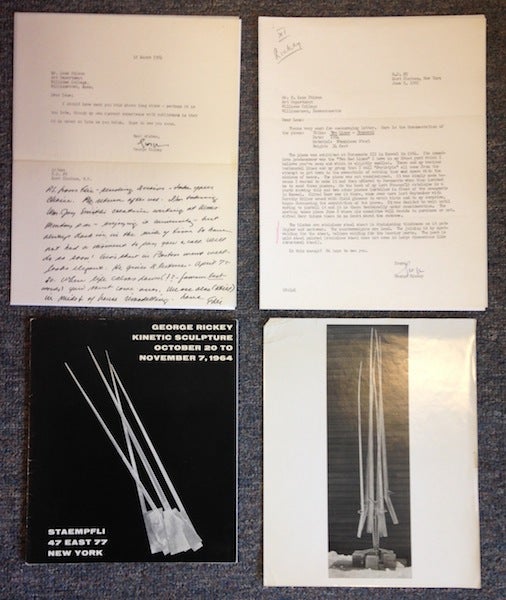Kinetic Sculptures, with Photographs & Two Letters
Boston & New York: Institute of Contemporary Art, & Staempfli, 1964. Wraps. Rickey, George Warren. Kinetic Sculptures. Boston: Institute of Contemporary Art, 1964. First edition; octavo; pp; (16); illustrated in black & white with sixteen (16) plates; original printed paper wrappers; very good. And, Rickey, George Warren. Kinetic Sculpture, October 20 To November 7, 1964. New York: Staempfli, 1964. First edition; octavo; Tri-fold Gallery Brochure for this One Man Exhibition; illustrated in black & white; original printed paper wrappers; very good. And; Glossy photograph of a sculpture measuring 8.5” x 11” with a (Tls) typed letter, signed from Rickey to noted art critic Lane Faison, dated 16 March, 1964. The letter apologizes for not sending the photo sooner. A long holograph addenda by “Edie” (spouse?) updates Faison on the creative writing course she is taking. And; (Tls) typed letter, signed from Rickey to noted art critic Lane Faison, dated June 2, 1965 from E. Chatham N.Y. The letter describes in detail a sculpture entitled, “Two Lines - Temporal” ; the size, materials etc. also the genesis of the piece. Where it was displayed, and it’s immediate destination, it is about to be sold. Rickey mentions that the piece is pictured on the rear of the Staempfli catalogue mentioned above. It is all part of a group called “Peristyle”. A great letter from the artist. Very good. Item #17307
George Rickey; Born in South Bend, Indiana, in 1907, Rickey was raised near Glasgow, Scotland. Rickey read modern history at Balliol College, Oxford, took classes in drawing at the Ruskin School, then studied painting in Paris at André Lhote's academy and at the Académie Moderne with Fernand Léger and Amédée Ozenfant. During the 1930s he painted first in a Cézannesque style, later in a Depression-era, social realist mode. He supported himself by teaching at Groton and at a series of colleges and universities.In World War II Rickey served in the Army Air Corps, testing computing instruments used by bomber gunners. The work required both mechanical skill and understanding the effects of wind and gravity on ballistics, laying the foundation of his move from painting to kinetic sculpture. Under the G.I. Bill, Rickey studied at the Institute of Fine Arts at New York University and from 1948-1949 attended the Institute of Design in Chicago, an outpost of Bauhaus teaching. Intrigued by both the history of constructivist art and by the mobiles of Alexander Calder, he began creating kinetic sculptures. In the 1950s and early 1960s, Rickey developed systems of motion for his sculpture that responded to the slightest variation in air currents. Over the next three decades he developed sculpture with parts made of lines, planes, rotors, volumes, and churns, moving in paths that change from simple oscillation to conical gyrations, describing a variety of planes or volumes. Many works during this period have been large-scale public commissions for sites in the United States, Europe, and Japan. Rickey died at home in St. Paul, Minnesota, on 17 July 2002 at the age of 95.
Samson Lane Faison, Jr. (November 16, 1907 – November 11, 2006) was an American art historian, professor, and director of the Williams College Museum of Art.
Price: $225.00


